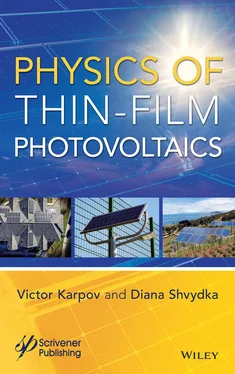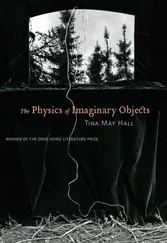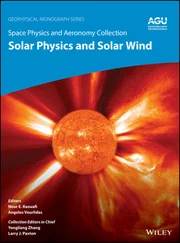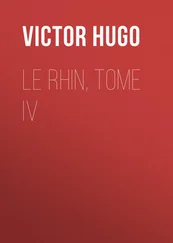1 Cover
2 Title Page
3 Copyright
4 Dedication
5 Preface
6 Part I General and Thin Film PVI. Introduction to Thin Film PV References
7 Part II One-Dimensional (1D) Diodes and PVII. 1D Diode III. 1D Solar Cell IV. Photovoltaic Parameters V. Case Study References
8 Part III Beyond 1D: Lateral Effects in Thin Film PVVI. Examples of Multidimensional Numerical Modeling VII. Introduction to Random Multidimensional Phenomena VIII. Lateral Screening Length IX. Schottky Barrier Nonuniformities X. Semi-Shunts XI. Random Diodes XII. Nonuniformity Observations XIII. Nonuniformity Treatment References
9 Part IV Electronic Processes in Materials of Thin Film PV XIV. Morphology, Fluctuations, and the Density of States XV. Electronic Transport XVI. Recombination in Quasi-Continuous Spectrum XVII. Noncrystalline Junctions XVIII Piezo and Pyro-PV References
10 Part V Electro-Thermal Instabilities in Thin Film PV XIX. The Two-Diode Model XX. Distributed Diode Model XXI. Simplistic Numerical Modeling XXII. Spontaneous Hot Spots XXIII. Related Work XXIV. Conclusions on the Electro-Thermal Instabilities in Thin Film PV References
11 Part VI Degradation of Thin Film PVXXV. Thin Film vs Crystalline PV Degradation Processes XXVI. Observations XXVII. Categories of Degradation XXVIII. Accelerated Life Testing References
12 Appendix. Some Methodological Aspects of Device Modeling Appendix A: Model of Series Connection Appendix B: The Diffusion Approximation Appendix C: Long Range Potential References
13 Index
14 Also of Interest
15 End User License Agreement
1 Part IITable I Front and Back contact properties: e/h refers to electron/hole propertie...Table II Layer properties: W - layer width, ϵ - dielectric constant, μ - mobilit...Table III Gaussian(mid gap) Defect States: N DG(AG); acceptor-like (donor-like) d...Table IV Matrix of correlation coefficients between several performance paramete...Table V Front and Back contact properties: e/h refers to electron/hole propertie...Table VI Layer properties: W is the layer width, ϵ - dielectric constant, μ - mo...Table VII Gaussian(mid gap) Defect States: N DG(AG)- acceptor-like (donor-like) ...Table VIII Performance parameters for three models: J sc- short circuit current,...
1 Part I Fig. 1 Conceptual design of a solar cell. Front and back contacts are metallic, ... Fig. 2 Band diagram of a metal/semiconductor/metal structure where E F1and E F2r... Fig. 3 Diffusion of the photogenerated electrons and holes to the electrodes in ... Fig. 4 In thin film devices, drift rather than diffusion can determine the kinet... Fig. 5 Role of grain boundaries in noncrystalline thin film PV. Left: Sketch of ... Fig. 6 A cross-sectional view of a superstrate (glass sheet up) CdTe based and s...
2 Part II Fig. 7 Energy band diagram of a symmetric potential barrier separating two metal... Fig. 8 Current-voltage characteristic of a system with symmetric barrier illustr... Fig. 9 Energy band diagram of an asymmetric potential barrier between two differ... Fig. 10 Current voltage characteristic of a system with asymmetric barrier illus... Fig. 11 Schottky barrier formation: (a) No electric contact; the Fermi level is ... Fig. 12 Gap states due to electron tunneling from the metal to dielectric side c... Fig. 13 Reach-through structure of a semiconductor layer sandwiched between two ... Fig. 14 Metal-semiconductor-metal structure before field compensation (a) and af... Fig. 15 The real space and energy space diagrams for the classical p-n homojunct... Fig. 16 Possible band diagram alignments with positive, zero, and negative Condu... Fig. 17 A rough sketch of the commonly used band diagram for CdTe and CIGS based... Fig. 18 The schematic structure and band diagram of a p-i-n diode. Fig. 19 The electron energy and field distribution for a two-layer (A,B) system ... Fig. 20 Top: a photograph of cat’s whisker diode [32]. Bottom: electrostatic int... Fig. 21 (a) Sketch of the electric field lines in a system with thin ellipsoidal... Fig. 22 Zero bias band diagram of a metal-semiconductor-metal model of solar cel... Fig. 23 The essential domain of current voltage characteristic of a diode struct... Fig. 24 Towards understanding of the nature of open circuit voltage ( V oc). Dashe... Fig. 25 The measured temperature dependence of V ocfor a CdTe solar cell and its... Fig. 26 External quantum efficiencies for the baseline CdS/CdTe (older generatio...Fig. 27 AMPS modeled band diagrams for CdTe and CIGS based PV. Reproduces with p...Fig. 28 AMPS modeled current voltage characteristics for CdTe (left) and CIGS (r...Fig. 29 Left: AMPS modeled IQE for CdTe and CIGS based PV. Right: Corresponding ...Fig. 30 Left: Energy band diagram of a graded CIGS solar cell based on a Ga dept...Fig. 31 Left: SCAPS simulation of the I(V) curves of a CdS/CdTe/Au solar cell, f...Fig. 32 Definition of the fill factor (FF) as the ratio of the areas of the smal...Fig. 33 Exaggerated sketches of the light (red) and dark (black) current voltage...Fig. 34 Statistics of nonideality factor for CdTe solar cells of efficiency grea...Fig. 35 The equivalent circuit of a PV device including the shunt ( R sh) and seri...Fig. 36 Histograms of statistical distributions of fill factors and short circui...Fig. 37 (a) Left: The ‘weak diode’ circuit where one diode has significantly low...Fig. 38 (a) Ideal diode with a resistor in series. (b) Ideal diode with a parall...Fig. 39 Phenomenological interpretation of dark to light IV crossings. The circu...Fig. 40 Conceivable band diagrams of CdS based PV. (a) p-n structure with n-type...Fig. 41 Phenomenological model of CdS based thin-film PV. σ represents the two-d...Fig. 42 Left: AMPS simulated (a) vs. analytical (b) J-V characteristics for the ...Fig. 43 Left: AMPS simulated band diagram at thermal equilibrium; 3 × 10 18cm -3...Fig. 44 Left: AMPS simulated band diagram at thermal equilibrium; where the acce...Fig. 45 ‘Hunch’ model characteristics. Left: AMPS simulated band diagram at ther...Fig. 46 AMPS generated light J – V characteristics and quantum efficiencies (QE)...Fig. 47 Band diagram of CdS based device corresponding to the case of “hunch mod...Fig. 48 Open circuit voltage ( V oc), short circuit current ( J sc), fill factor (FF...Fig. 49 Towards the effect of CdS leakiness on the integral device V oc= V oc2− ...Fig. 50 (a) Current-voltage characteristics of the good back contact (Good BC) a...Fig. 51 (a) The band diagram of the main junction (left part) and a moderate (tr...
3 Part IIIFig. 52 (a) The equivalent circuit design of a 1D thin film solar cell; R can re...Fig. 53 The electric potential distributions in a semi-infinite one dimensional ...Fig. 54 The electric potential distribution in a dot cell under forward and reve...Fig. 55 An example of the current-voltage characteristic for an infinitely large...Fig. 56 The measured electric potential distributions (a) in a shunted PV strip ...Fig. 57 Multidimensional diagrams of Schottky barriers. x - axis points into the...Fig. 58 (a) A semi-shunt of length a < L in comparison with a dead metal shunt s...Fig. 59 The histograms of the open-circuit and short-circuit resistances showing...Fig. 60 (a) A representative IV curves of a ‘good’ and ‘bad’ (low V oc) nominally...Fig. 61 Left: back metal deposited on the interfacial layer (IFL) will generate ...Fig. 62 Left: Current-voltage characteristics and equivalent circuit of a weak d...Fig. 63 Simulated open-circuit voltage ( V oc), electric potential (V), and transv...Fig. 64 Electric potential variations in a 2D system of random diodes numericall...Fig. 65 (a) Fluctuations of micro-diode
Читать дальше












